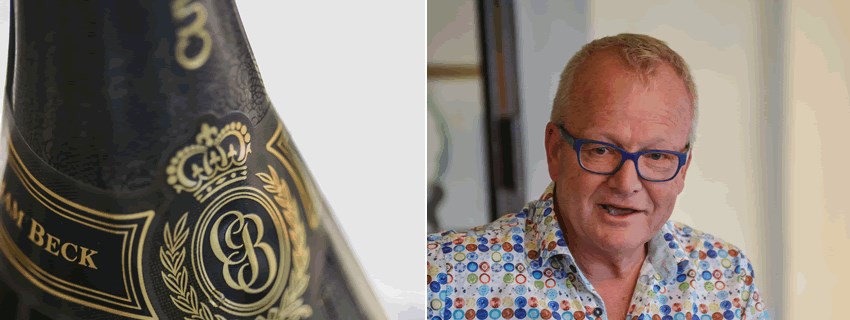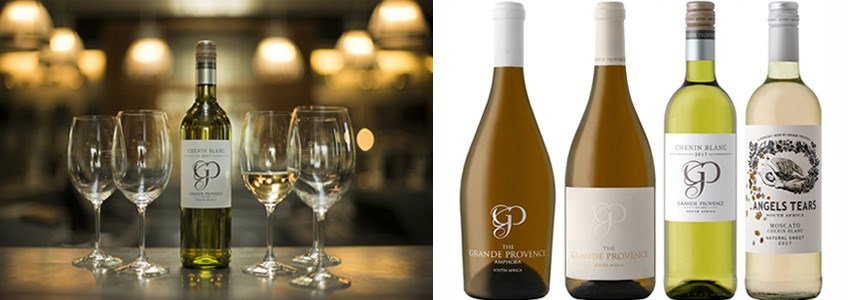At a benchmark tasting of the proprietor’s collection wines in the Graham Beck stable at the Silo Hotel at the V&A Waterfront like the ancient mariner we could see water, water everywhere out in Table Bay but not a drop to drink. (A surfeit of fine wine more than made up for it). Cellarmaster Pieter Ferreira commented on the impact of what he calls the worst drought he’s seen in the winelands in thirty years.
Over a tasting of Beck’s flagship Cuvée Clive magnificent MCC 2003 and 2013, “Bubbles” Ferreira explained the drought really starts to show in the third year of the cycle when stressed vines have depleted energy resources. He says drought vines are rather like leaf roll virus – producing lower yields and smaller bunches. New vines are maturing faster with lower, stunted canopies. Robertson has seen a 70% reduction in water supply –and harvested ten days later this year for MCC base wine.

The selling off of the still wine silverware in the Graham Beck stable was well-timed. Pieter adds, “All the side-shows have gone. Our focus is on bubbly as the essence of Graham Beck. Now we’re only doing bubbles, we can make Cuvée Clive every year – showcasing our new clonal selection of Chardonnay and Pinot Noir from mature vineyards.” After years of watching alcohol levels rise, he says an inversion of sugar levels means lower alcohols as the base wines ferment completely dry.”
Winemaker Alban Debeaulieu presented the highly prized single vineyard Oregon Pinot Noir in the proprietor’s collection - Angela Vineyard and Abbott Claim Pinot Noir (rated one of the top Pinot vineyards in the USA) – across the 2011 – 2013 vintages. He complained of “a biblical rainstorm of seven inches”on harvest day in 2012 – a predicament many growers and consumers might pray for in South Africa. But these iconic Pinots from terroir developed by Ken Wright, a legendary Oregon winemaker, were far from watery; concentrated wines of perfumed delicacy and lush suppleness.
It’s not often you get to meet a quartet of top winemakers at a single tasting of four premium terroirs (Constantia, Stellenbosch, Robertson and Oregon) around the same table. A superb lunch pairing in the high altitude Wisdom Room at the Silo Hotel was a learning curve for wine writers. The event hosted by Antony Beck also featured the other flagships in the super-premium collection – Steenberg Magna Carta and Lady R MCC by cellarmaster JD Pretorius and Capensis Chardonnay (a joint SA/US Beck/Jackson Wines venture) by winemaker Therese de Beer.
One lesson may well be that South Africa’s premium wine market is buoyant while the drought is shrinking volumes of South Africa’s bulk wine market – and pushing up grape and wine prices.
Water and wine were one of the many key issues at the twenty-fifth anniversary celebrations of Jordan Wine Estate in late 2017. Cellarmaster Gary Jordan and winemaker Sjaak Nelson discussed how the drought may change viticultural practises and wine styles, especially when it comes to varieties such as Sauvignon Blanc. Leaving more canopy and leaf on vines to protect the grapes from higher temperatures could see a trend back to greener, more herbaceous flavours in wines.
The landmark event of this quintessential family winery was celebrated with a maiden Jordan Blanc de Blanc 2015 out of their new MCC cellar – sold only at the cellar-door. The occasion offered a tasting of rare vintages of Jordan’s flagships – inter alia Barrel Fermented 1995 and 2007 (under cork and screwcap) and Nine Yards Chardonnay 2010, Cabernet Sauvignon 1993 and 1995 and the Bordeaux Cobbler’s Hill 2001 and 2010 – as well as CWG Sophia 2013. Attention to detail means testing every single cork on top-end reds after the switch to screwcaps a decade ago.
Looking back on “the luck of the Jordan’s”, Gary says the first Chardonnay vineyard he planted is being replaced “when we have enough water to plant new vines!” Advised in the early 1990s, “Don’t plant (Cape) Riesling, plant Chardonnay” has paid dividends for this benchmark Chardonnay producer today.
Discussions at recent tastings have even touched on which varieties are thirsty (Sauvignon Blanc and Merlot?), which more drought resistant (eg, Rhone and Mediterranean varieties) and whether dryland bushvines are better suited to drought conditions. At a delightful “Expression of Chenin Blanc” tasting at Grande Provence in mid-February, new winemaker Hagen Viljoen (ex-Solms Delta) declared the winery aims to be “the flagbearer for Chenin Blanc in the Franschhoek Valley”.
“No-one is telling the Chenin story in our valley” adds Hagen. Their new Chenin Blanc 2017 (a blend of Stellenbosch and Franschhoek grapes) is a best-seller at the cellar-door – and joins a line-up of Grande Provence Amphora (from their 35 year-old bushvine Chenin), the flagship Grande Provence White (a Chenin-led blend with Viognier and Chardonnay) and Angels Tears Moscato Chenin. New chef Guy Bennett (ex-Delaire and Overture) created a fabulous food pairing for the Chenin quartet.

If Chenin is South Africa’s white grape hero, Pinotage is its signature red. According to the Pinotage Association, the 2018 harvest will be marked by smaller berries, lighter bunches and lower yields - but the quality of the grapes is promising. Kanonkop winemaker Abrie Beeslaar says that while the drought has made for challenging times with 10% lower yields, it is heartening to see how well Pinotage vines are handling adverse weather conditions – a true testament to how well this uniquely South African cultivar has adapted to the environment.
Kaapzicht cellarmaster Danie Steytler, another key Pinotage producer, predicts that the dryland, older vineyards in particular will probably yield much less in 2018. Although they are seeing a close-to-normal bunch count per vine in Bottelary, the sizes of bunches and berries are considerably smaller. Beyers Truter of Beyerskloof,the prophet of Pinotage adds that cool summer nights have contributed to great tannin structure, good fruit extracts, exceptional colour and flavour. “This looks like a brilliant year for Pinotage,” he concludes.
Cellar master Johan Malan of Simonsig quips that water is on everyone’s lips. He comments, “A very small vintage has been predicted for South Africa in a year when more wine will be consumed than produced worldwide. The harvest started about a week later on 18 January with Pinot noir for Kaapse Vonkel. Grape quality has been excellent so far and it is one benefits of the extremely dry summer. It is no surprise that acidity levels are lower than normal. Our aim was to pick at slightly lower sugar levels than in previous years to preserve the natural acidity of the grapes.” While the rest of us are harvesting rain, growers are harvesting grapes in a balancing act of managing wine and dwindling water resources.